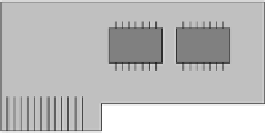Information Technology Reference
In-Depth Information
11
AGP
11.1 Introduction
The AGP (accelerated graphics port) is a major advancement in the connection of 3D graph-
ics applications, and is based on an enhancement of the PCI bus. One of the major motivat-
ing factors is to improve the speed of transfer between the main system memory and the lo-
cal graphics card. This reduces the need for large areas of memory on the graphics card, as
illustrated in Figure 11.1.
The main gain in moving graphics memory from the display buffer (on the graphics card)
to the main memory is the display of text information as:
•
It is generally read-only, and does not have to be displayed in any special order.
•
Shifting text does not require a great deal of data transfer and can be easily cached in
memory, thus reducing data transfer. A shift in text can be loaded from the cached mem-
ory.
•
It is dependent on the graphics quality of the application, rather that the resolution of the
display. There is thus great scope in the future for improvement in the quality of graphics
images, rather than their resolution.
•
It is not persistent, as it resides in memory only for the duration that it is required. When
it has completed the main memory it can be assigned to another application. A display
buffer, on the other hand, is permanent.
On-board
memory to
store graphics
System
memory
PCI-based
graphics card
AGP-based
graphics card
Figure 11.1
AGP card using main system memory















